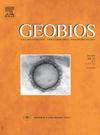台湾中中新世三个具最早棘足类(棘皮科:棘足总科)化石记录的棘足类组合
IF 1.6
4区 地球科学
Q2 PALEONTOLOGY
引用次数: 0
摘要
刺果纲(棘科:刺果纲)是现存刺果纲的基础类群。然而,在新生代化石记录中相对缺乏完整的cidaroid测试,这对了解其生物地理模式和进化趋势提出了挑战。本研究报道了200 m厚的中中新世南岗组,包括“Cidaroida组合”、“asstriclypeoidea组合”和“Spatangoida组合”三个针孔类组合。讨论了潜在的古环境意义,并与环地中海地区广泛分布的中新世棘刺类动物进行了比较。值得注意的是,从Cidaroida组合中发现了一个具有完整脊柱的铰接cidaroid化石。该标本具有浅而横向的卵圆形微孔,以及明显的杆状棘状原刺,表明它属于Prionocidaris属。综上所述,Prionocidaris化石是该目在台湾最早出现的化石,其伴生的棘类动物组合为未开发的西太平洋地区提供了宝贵的记录。本文章由计算机程序翻译,如有差异,请以英文原文为准。
Three echinoid assemblages with the earliest cidaroid (Echinodermata: Echinoidea) fossil record from the Middle Miocene of Taiwan
Cidaroids (Echinoidea: Cidaroida) are the basalmost taxa among extant echinoids. However, the relative scarcity of intact cidaroid tests in the Cenozoic fossil record poses challenges for understanding their biogeographic patterns and evolutionary trends. This study reports the 200-meter thick Middle Miocene Nangang Formation, including three echinoid assemblages, namely “Cidaroida assemblage”, “Astriclypeoidea assemblage”, and “Spatangoida assemblage”. The potential paleoenvironmental implications and comparisons to widespread Miocene echinoid faunas of the circum-Mediterranean area are discussed. Notably, an articulated cidaroid fossil with intact spines recovered from the Cidaroida assemblage. The specimen exhibits shallow and transverse oval areoles along with distinct, rod-like, spinose primary spines, suggesting that it belongs to the genus Prionocidaris. In summary, the Prionocidaris fossil stands as the earliest occurrence of this order in Taiwan, and the associated echinoid assemblages offer a valuable record in the underexplored Western Pacific Region.
求助全文
通过发布文献求助,成功后即可免费获取论文全文。
去求助
来源期刊

Geobios
地学-古生物学
CiteScore
3.30
自引率
6.20%
发文量
28
审稿时长
6-12 weeks
期刊介绍:
Geobios publishes bimonthly in English original peer-reviewed articles of international interest in any area of paleontology, paleobiology, paleoecology, paleobiogeography, (bio)stratigraphy and biogeochemistry. All taxonomic groups are treated, including microfossils, invertebrates, plants, vertebrates and ichnofossils.
Geobios welcomes descriptive papers based on original material (e.g. large Systematic Paleontology works), as well as more analytically and/or methodologically oriented papers, provided they offer strong and significant biochronological/biostratigraphical, paleobiogeographical, paleobiological and/or phylogenetic new insights and perspectices. A high priority level is given to synchronic and/or diachronic studies based on multi- or inter-disciplinary approaches mixing various fields of Earth and Life Sciences. Works based on extant data are also considered, provided they offer significant insights into geological-time studies.
 求助内容:
求助内容: 应助结果提醒方式:
应助结果提醒方式:


